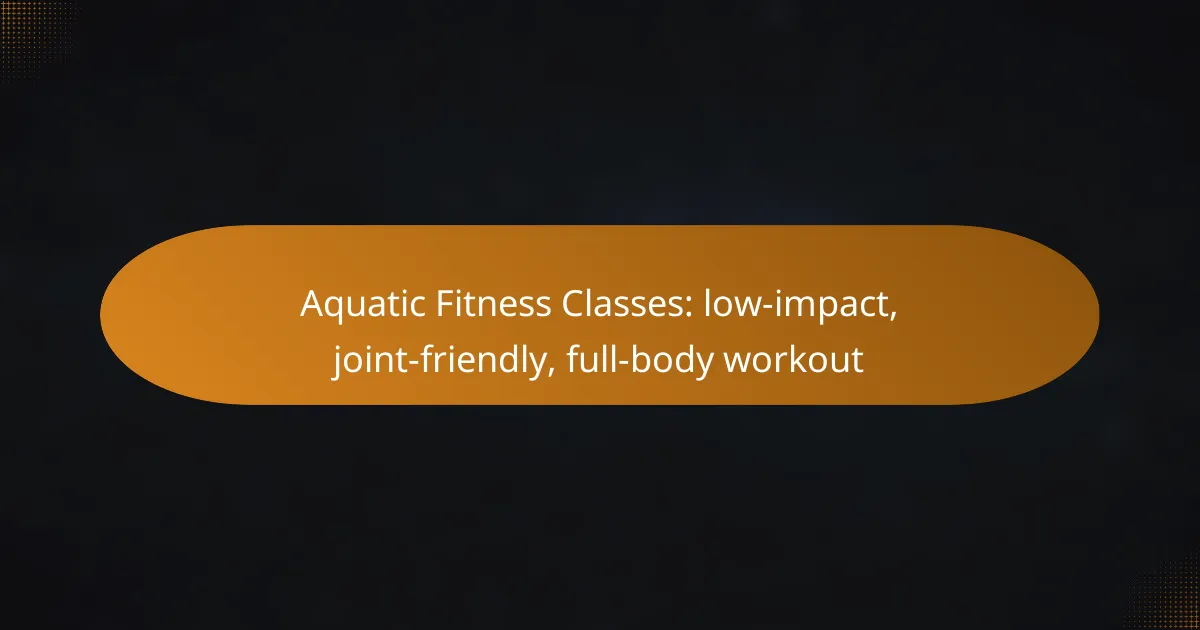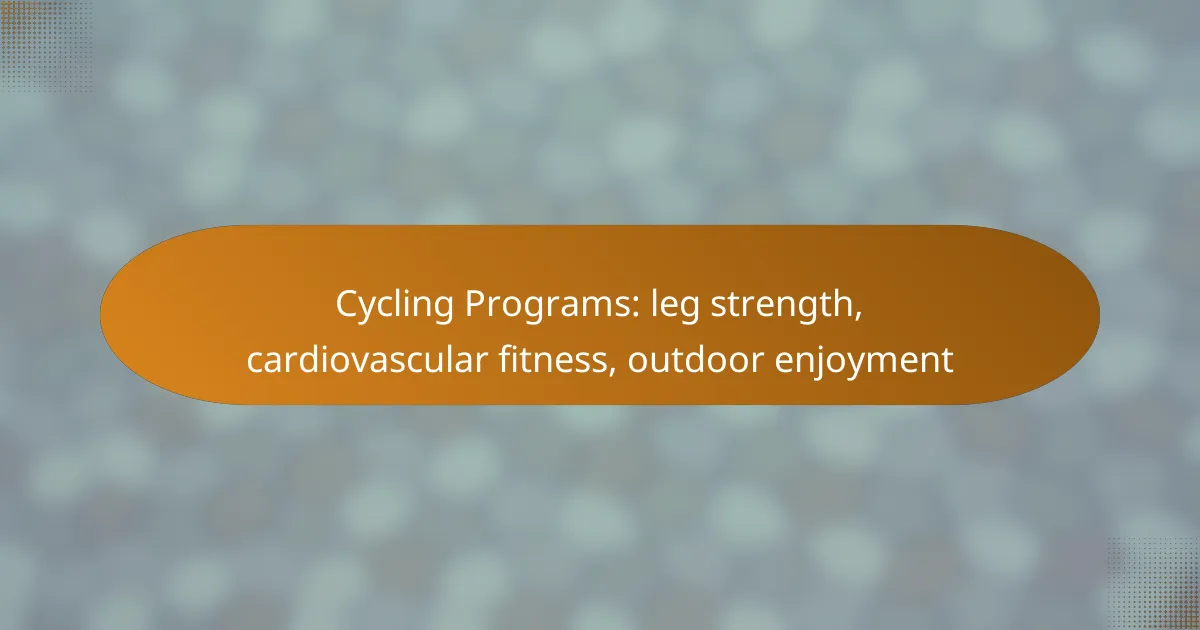Aquatic fitness classes provide an excellent opportunity for low-impact, joint-friendly exercise that engages the entire body. These workouts are tailored to enhance strength, flexibility, and cardiovascular health while reducing stress on the joints, making them accessible for participants of all fitness levels.

What are the benefits of aquatic fitness classes?
Aquatic fitness classes offer numerous benefits, including low-impact exercise, joint-friendly workouts, and full-body conditioning. These classes are designed to enhance overall fitness while minimizing stress on the body, making them suitable for a wide range of participants.
Low-impact exercise
Aquatic fitness classes provide low-impact exercise options that reduce the risk of injury. The buoyancy of water supports the body, allowing participants to engage in movements that might be difficult on land. This makes it ideal for beginners, older adults, or those recovering from injuries.
Exercises such as water aerobics or swimming can elevate heart rates while being gentle on joints. This means individuals can achieve effective workouts without the strain often associated with high-impact activities.
Joint-friendly workouts
Joint-friendly workouts are a hallmark of aquatic fitness classes, as water reduces the impact on joints during exercise. This is particularly beneficial for individuals with arthritis or chronic pain conditions, as the water’s resistance helps build strength without exacerbating discomfort.
Participants can perform a variety of movements, such as leg lifts and arm strokes, while the water provides a cushioning effect. This allows for a wider range of motion and encourages safe, effective workouts.
Full-body conditioning
Aquatic fitness classes promote full-body conditioning by engaging multiple muscle groups simultaneously. The resistance of water makes every movement a strength-building exercise, targeting arms, legs, core, and back muscles.
Classes often incorporate a mix of cardio and strength training, ensuring a balanced approach to fitness. For example, participants might alternate between water jogging and resistance exercises using foam weights, maximizing their workout efficiency.
Improved flexibility
Improved flexibility is another key benefit of aquatic fitness classes. The warm water allows muscles to relax, making it easier to stretch and increase range of motion. Regular participation can lead to noticeable improvements in flexibility over time.
Instructors often include stretching routines as part of the class, focusing on major muscle groups. This not only enhances flexibility but also helps prevent injuries and improves overall performance in other physical activities.
Enhanced cardiovascular health
Enhanced cardiovascular health is a significant advantage of engaging in aquatic fitness classes. The resistance of water provides an effective way to elevate heart rates, promoting better circulation and overall heart health.
Participants can experience cardiovascular benefits similar to those from traditional aerobic exercises, such as running or cycling, but with less risk of injury. Consistent attendance in these classes can contribute to improved stamina and endurance over time.

Where can I find aquatic fitness classes in the US?
Aquatic fitness classes in the US can be found at various locations, including community centers, YMCA facilities, and private gyms with pools. These venues typically offer a range of low-impact, joint-friendly workouts suitable for all fitness levels.
Local community centers
Many local community centers provide aquatic fitness classes that cater to different age groups and fitness levels. These classes often focus on low-impact exercises that are gentle on the joints, making them ideal for seniors or those recovering from injuries.
To find a community center near you, check your city or county’s official website or visit local bulletin boards. Class schedules and fees can vary, but many centers offer affordable rates, often under $10 per session.
YMCA facilities
YMCA facilities across the US are well-known for their comprehensive aquatic fitness programs. They typically offer a variety of classes, including water aerobics, aqua yoga, and swim fitness, all designed to provide a full-body workout while minimizing joint stress.
Membership at the YMCA can provide access to these classes, often with additional benefits such as family rates and discounts for students or seniors. It’s advisable to check the specific YMCA branch for class availability and pricing, which can range from $30 to $100 monthly.
Private gyms with pools
Many private gyms also feature pools and offer specialized aquatic fitness classes. These facilities may provide a more intimate setting with smaller class sizes, allowing for personalized attention from instructors.
When considering a private gym, look for those that emphasize low-impact workouts and have certified instructors. Membership costs can vary widely, typically ranging from $50 to $150 per month, depending on the amenities and location.

What types of aquatic fitness classes are available?
Aquatic fitness classes offer a variety of low-impact, joint-friendly workouts that engage the entire body. These classes are designed to improve strength, flexibility, and cardiovascular health while minimizing stress on the joints.
Aqua aerobics
Aqua aerobics involves performing aerobic exercises in shallow water, typically at a pool’s edge. Participants use the buoyancy of the water to reduce impact on joints while enhancing cardiovascular endurance and muscle strength.
Classes often incorporate various movements like jumping jacks, leg lifts, and arm exercises, all set to music. Sessions usually last around 45 minutes to an hour, making them accessible for all fitness levels.
Water Zumba
Water Zumba combines traditional Zumba dance moves with the resistance of water, creating a fun, energetic workout. The water’s buoyancy helps participants perform dance steps with less strain on their bodies.
Classes are typically held in shallow water and last about 45 minutes. The focus is on rhythm and enjoyment, making it a great option for those looking to socialize while exercising.
Swim fitness programs
Swim fitness programs focus on improving swimming techniques and overall fitness through structured workouts. These classes cater to various skill levels, from beginners to advanced swimmers, and often include drills to enhance stroke efficiency and endurance.
Sessions can range from 30 minutes to an hour and may incorporate interval training, distance swimming, and technique refinement. Participants should be comfortable in the water and have basic swimming skills.
Water yoga
Water yoga adapts traditional yoga poses to a pool environment, using the water’s support to enhance flexibility and balance. This class is ideal for those seeking a gentle, restorative workout that promotes relaxation and mindfulness.
Classes typically last around 60 minutes and may include breathing exercises and meditation. The water’s buoyancy allows for deeper stretches and can be particularly beneficial for individuals with mobility issues or joint pain.

How do I choose the right aquatic fitness class?
Choosing the right aquatic fitness class involves understanding your personal fitness goals, the intensity of the class, and the qualifications of the instructor. By evaluating these factors, you can find a class that suits your needs and promotes a safe, effective workout.
Consider fitness goals
Your fitness goals are crucial in selecting an aquatic fitness class. Whether you aim to improve cardiovascular health, build strength, or enhance flexibility, different classes cater to various objectives. For instance, water aerobics may focus on endurance, while aqua yoga emphasizes flexibility and relaxation.
Define your primary goals before enrolling. If weight loss is a priority, look for classes that incorporate high-intensity intervals. For rehabilitation or joint-friendly exercises, seek out gentle classes designed for low-impact movements.
Assess class intensity
Consider attending a trial class to gauge the intensity before committing. Many facilities offer introductory sessions, allowing you to experience the class atmosphere and determine if it aligns with your fitness capabilities.
Evaluate instructor qualifications
The qualifications of the instructor can greatly impact your experience in an aquatic fitness class. Look for instructors who hold certifications in aquatic fitness or related fields, as this indicates a level of expertise in leading safe and effective workouts.
Inquire about the instructor’s experience and training background. A qualified instructor should be able to provide modifications for different fitness levels and ensure that all participants are exercising safely, particularly in a low-impact environment.

What equipment is used in aquatic fitness classes?
Aquatic fitness classes utilize various equipment designed to enhance workouts while being gentle on the joints. Common tools include water dumbbells and kickboards, which help participants engage in resistance training and improve buoyancy during exercises.
Water dumbbells
Water dumbbells are specially designed weights that provide resistance while submerged in water. They are typically made of foam or plastic and come in various sizes to accommodate different fitness levels. Using water dumbbells can help strengthen muscles without putting undue stress on the joints.
When using water dumbbells, focus on maintaining proper form to maximize effectiveness. Start with lighter weights to get accustomed to the resistance, then gradually increase the size as your strength improves. A common approach is to perform exercises like bicep curls or lateral raises for about 10-15 repetitions.
Kickboards
Kickboards are flotation devices that assist in swimming and aquatic exercises by providing buoyancy. They help stabilize the body, allowing participants to focus on leg movements and improve cardiovascular fitness. Kickboards are particularly useful for beginners or those recovering from injuries.
To effectively use a kickboard, position it under your arms and kick your legs to propel yourself through the water. This can be done in a variety of ways, such as flutter kicks or dolphin kicks, for durations of 30 seconds to a minute. Incorporating kickboards into your routine can enhance leg strength and endurance.



